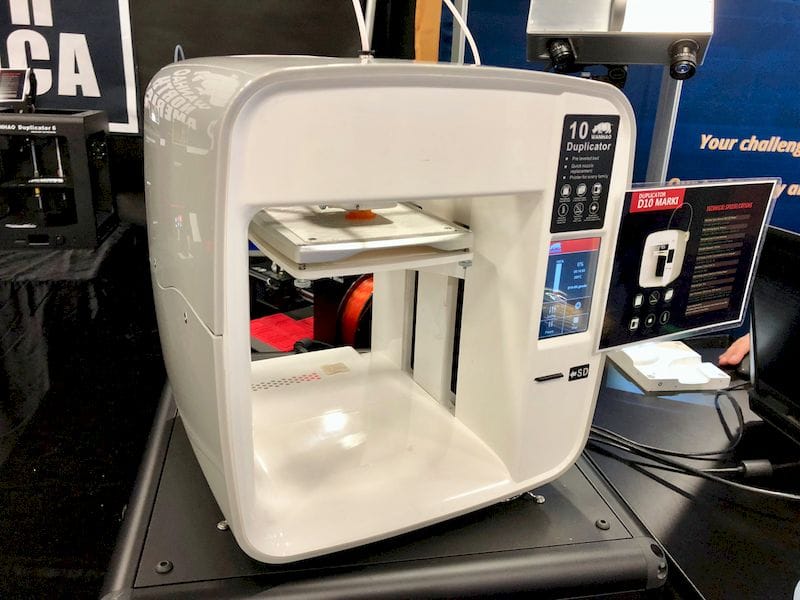![The Wanhao Duplicator 10 desktop 3D printer [Source: Fabbaloo]](https://fabbaloo.com/wp-content/uploads/2020/05/image-asset_img_5eb0a9675fd21.jpg)
Wanhao is a familiar name to those shopping for desktop 3D printers.
The China-based company has been producing a variety of desktop units for several years, with many being highly regarded as well as low-priced.
Like many 3D printer manufacturers, Wanhao’s products have gone through a progression of technical evolution, beginning with a basic model and increasingly gaining sophistication. Beginning with filament extrusion models, the company now offers resin-based equipment as well.
Their equipment is sometimes sold under a white-labeling program. Some Monoprice 3D printers are actually slightly modified Wanhao devices, for example. Their sales are correspondingly higher than you might expect.
Their current model, the Duplicator 10, shown at top, incorporates many of the learnings they’ve developed over several years. The attractive unit is positioned as a device for beginners and includes a number of ease-of-use features, such as auto loading, print presets, as well as a low price in the USD$300 range.
But they also offer the Duplicator 9:
![The Wanaho Duplicator 9 desktop 3D printer [Source: Fabbaloo]](https://fabbaloo.com/wp-content/uploads/2020/05/image-asset_img_5eb0a967e1fd1.jpg)
And the Duplicator 8:
![The Wanaho Duplicator 8 desktop 3D printer [Source: Fabbaloo]](https://fabbaloo.com/wp-content/uploads/2020/05/image-asset_img_5eb0a96843bec.jpg)
And the Duplicator 7 Plus:
![The Wanaho Duplicator 7Plus desktop 3D printer [Source: Fabbaloo]](https://fabbaloo.com/wp-content/uploads/2020/05/image-asset_img_5eb0a968a2de5.jpg)
And the Duplicator 7:
![The Wanaho Duplicator 7Plus desktop 3D printer [Source: Fabbaloo]](https://fabbaloo.com/wp-content/uploads/2020/05/image-asset_img_5eb0a968ebf71.jpg)
And the Duplicator 6:
![The Wanaho Duplicator 7Plus desktop 3D printer [Source: Fabbaloo]](https://fabbaloo.com/wp-content/uploads/2020/05/image-asset_img_5eb0a9695d151.jpg)
And the Duplicator 5S Mini:
![The Wanaho Duplicator 5S Mini desktop 3D printer [Source: Fabbaloo]](https://fabbaloo.com/wp-content/uploads/2020/05/image-asset_img_5eb0a969bb4fc.jpg)
And the Duplicator i3 Plus:
![The Wanaho Duplicator i3 Plus desktop 3D printer [Source: Fabbaloo]](https://fabbaloo.com/wp-content/uploads/2020/05/wanhaoi3-1_result_img_5eb0a96a2f315.jpg)
And the Duplicator i3 Mini:
![The Wanaho Duplicator i3 Mini desktop 3D printer [Source: Fabbaloo]](https://fabbaloo.com/wp-content/uploads/2020/05/image-asset_img_5eb0a96aa9ad4.jpg)
And there are even more models available from the company. Wanhao offers a lot of 3D printers, and many of them are actually very similar in features and pricing.
![Wanaho's current line of desktop 3D printers [Source: Fabbaloo]](https://fabbaloo.com/wp-content/uploads/2020/05/wanhaoall-1_result_img_5eb0a96b0720b.jpg)
One wonders why they would continue to market older models, as most manufacturers would retire older models to make room on their manufacturing lines for the presumably better selling current models. Why would Wanhao keep all these similar models?
I asked them.
The answer was simple and obvious: “Because people still buy them!”
Well, this does make business sense from the company’s point of view, but it also begs the question: why would people buy older models when newer ones are readily available?
I think this is evidence that a large portion of the inexpensive desktop buying market is poorly informed. A relatively straightforward check of specifications and pricing should direct any buyer towards the right kind of equipment, but perhaps the buying public in general doesn’t yet understand those specifications?
I suppose this is the same phenomenon I see with other consumer products. It always baffles me why people might purchase certain types of automobiles, for example.
Maybe I’ll be baffled on 3D printer purchasing habits, too.
Via Wanhao

